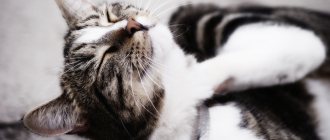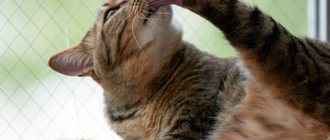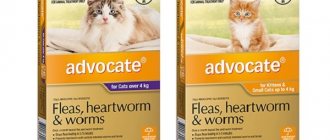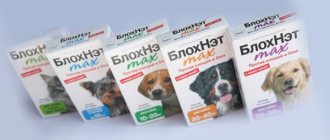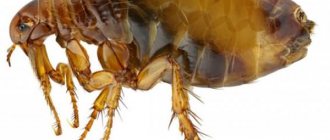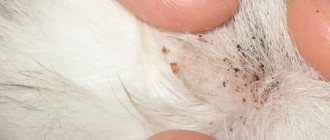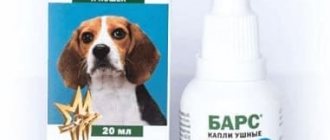Treating your pet with anti-flea drops
Possible illnesses for a cat if it licks flea drops
Many owners of furry pets wonder what will happen if a cat licks flea drops. The situation is especially alarming when the kitten licks the product. It is impossible to say that there is no cause for concern. But you shouldn’t worry too much about this if you react correctly to what happened.
Is poisoning from flea drops dangerous?
The insecticides that form the basis of the drugs in this line are contained in the minimum required concentrations. They contain just enough active substances to kill insects without causing harm to the animal. Even a significant amount of licked flea drops will not cause death, but there is a danger of poisoning.
Even a veterinarian will not give a definite answer to what will happen if a cat licks flea drops. The determining factors are:
- combination of active ingredients and their concentration in the medicine;
- the number of drops that got inside (usually, if they accidentally hit the oral mucosa, they cause bitterness in the animal, prompting the animal to refuse further licking from the treated area of fur);
- cat immunity;
- age and weight of the animal.
Drops on the withers
Flea repellent poisoning may have no symptoms in a healthy adult cat. However, old, recently severely ill and fragile young animals will feel seriously unwell from the medicine. Symptoms can last from a couple of hours to several days.
Safety precautions for application
The manufacturer's recommendations indicate that the composition should be applied to the area between the shoulder blades along the spine. The cat will not be able to turn its head so as to reach the withers area.
Unfortunately, correct application does not provide a 100% guarantee of protection against droplets getting into the animal. To prevent flea treatment from causing poisoning, you should adhere to the following rules:
- do not apply drops in a long line (an area of 2 cm is sufficient);
- try to distribute the medicine closer to the hair roots;
- If there are several cats in the house, isolate them from each other during treatment.
You can try to protect especially resourceful cats by attaching a collar to the neck. It will fix the head and prevent it from reaching the areas treated with insecticide. The time for complete absorption of the drug is about 2 hours (manufacturers indicate the exact period in the annotation). After this, the remaining drops become completely safe.
Additional necessary measures
Owners of cats infected with fleas must take into account the unpleasant fact that parasites lay eggs throughout the home. In addition to eggs, there may be larvae and cocoons in the house where a pet suffering from bloodsuckers lives.
- The insects themselves can also be outside the animal’s body, because they rarely breed directly in the fur, preferring secluded, inaccessible corners where the cat usually sleeps, eats, and rests.
- Therefore, the treatment of the entire home must necessarily go in parallel with bathing and combing.
- To prevent new flea attacks on your pet, use any convenient protective product. Fortunately, their choice on the zoological goods market is wide.
- You can choose drops, collar or spray. This will allow you to protect your meowing friend for a long time and reliably from possible future invasions of parasites dangerous to health and life.
We suggest you familiarize yourself with Caring for cherries in summer, autumn and spring after harvest: pruning and watering
Important! Remember that fleas can bite people too. Therefore, remove parasites from your pets in a timely manner, or better yet, use preventive protective agents, and then your home will be clean and inaccessible to bloodsuckers, and your entire family, including your cat, will be healthy and not bitten
Signs of poisoning
The cat, by licking drops of fleas, ensures that insecticides enter the gastrointestinal tract. Therefore, the main symptoms of poisoning manifest themselves from this body system. The most common sign that a cat has licked Bars flea drops or another popular brand is excessive salivation, thirst and loss of appetite. Harmless symptoms disappear spontaneously after a couple of days.
Attention! Drops, once on the mucous membrane of the mouth and esophagus, provoke severe dryness. Hence the animal’s desire to drink a lot of water. Thirst plays into your hands in such a situation; it helps to quickly remove toxins from the body.
For poisoning from flea drops to manifest itself in full force, the animal must swallow almost the entire contents of the bottle or have poor immunity. Signs of severe intoxication:
- vomit;
- diarrhea;
- lethargy and passivity;
- greatly dilated pupils;
- trembling and convulsions.
If a cat has licked off flea drops, it may become very unsteady and skid when running or walking. Before jumping, the animal takes a long time to try it on due to disorientation in space.
Vomit
In addition to poisoning, flea drops sometimes cause an allergic reaction. This usually happens when the dosage is violated or an untested brand of the drug is used. Symptoms of intolerance:
- profuse lacrimation;
- local itching and redness of the skin;
- the appearance of bald spots at the site of application of the medicine.
In these cases, the cause of the symptoms has nothing to do with ingestion of the drops. To eliminate them, the applied composition is washed off, and other lines of products are used to treat fleas.
What to do if your cat is poisoned?
When a cat is poisoned by flea drops, the recovery period depends on the measures taken by the owner, who must know what to do first to stop the manifestations of intoxication and how to provide basic treatment. Particular attention is paid to the nutrition of the affected cat.
First aid for an animal
Treatment of a cat poisoned by flea drops begins with sorbent agents. Medicines in this group relieve attacks of nausea, act like a sponge, absorbing insecticides and preventing them from penetrating the blood.
For representatives of the cat family, the medications listed in the table are suitable:
| Name of medicine | Dosage |
| Activated carbon | 1 tablet per 1 kg of cat weight, 3-4 times a day |
| Polysorb | 0.1-0.2 g per 1 kg of body weight |
| Filtrum | 7 g of the drug is diluted in 50 ml of water and given to the pet 2-4 ml per 1 kg of body weight |
| Enterosgel | 1 cm of paste, squeezed onto a spoon |
| Smecta | 1-2 ml of solution per 1 kg of animal weight, 2-5 times a day |
They bind and remove toxins, as a result of which digestion is normalized, intestinal motility and kidney function are improved.
The second most common symptom that occurs if a cat licks flea drops is diarrhea. Smecta will handle its elimination. Additionally, rice or chamomile infusion is given. It is prepared from 1 tbsp. cereals (or dried vegetable collection) and 1.5 tbsp. water. The ingredients are boiled, filtered, cooled and given to your pet to drink.
Treatment of a poisoned cat
Poisoning with flea drops, even with proper and timely treatment, does not go away in a couple of hours. To help your pet, you will have to organize a full-fledged therapeutic course. It is convenient to use a syringe without a needle to administer medications. A healing solution is injected into it, the required amount of which is determined using a measuring scale on the body of the device.
Introduction technique:
- hold the cat motionless;
- throw back the animal's head;
- press your fingers on both sides into the area between the lower and upper teeth;
- pour the drug solution into the cheek in small portions.
The medicine Drotaverine (NoShpa) or Baralgin will help against flea poisoning accompanied by pain. Taking these medications does not have the best effect on the animal’s digestion. After the therapy, the intestinal microflora will have to be restored. The drug Vetelact will cope well with the task.
Vetelakt
If intoxication caused by poisoning with flea drops does not go away and the cat spits out all the medicine, injections into the thigh area are allowed. However, the veterinarian must give the injections.
Feeding a cat after poisoning
Properly organized nutrition is one of the main conditions that determine how quickly a cat will recover. If a cat is poisoned with flea drops, it is deprived of food for a day. The digestive tract irritated by insecticides must be protected from stress. It is advisable to clean the full stomach by inducing vomiting in the cat. If necessary, do an enema.
Strong thirst after intoxication is a good sign. The more the animal drinks, the sooner the recovery will occur. For weakened cats that refuse fluids, water is forcibly infused at a rate of 5 ml at a time.
When the main symptoms of poisoning pass, the pet is transferred to a diet menu of cereals, chicken broth and fermented milk products. Meat and dry food are banned for a week.
Features of kitten treatment
It becomes more difficult when a kitten is poisoned by flea drops. It receives the same concentration of insecticides, and its body weight is several times less than that of an adult animal. In order not to risk your pet’s health, at the slightest sign of discomfort, it is better to contact a veterinarian.
In general, the technology for treating kittens is the same as for adults. It is supplemented with the following groups of drugs:
- decoctions that give a diuretic effect (lingonberries, bearberry, tansy, St. John's wort are suitable);
- veterinary medications that support the functioning of the liver (Hepatovet, Hepatolux, Gepasafe, Corsil);
- saline and glucose to support animals with severe dehydration.
The standard course of treatment is 30 days, but if necessary, it is adjusted by the veterinarian based on the general condition of the patient and the emerging dynamics.
Infectious skin diseases
Ringworm is a skin disease accompanied by:
- the formation of a small rash;
- damage to fur and claws.
This disease can occur due to a viral infection or reduced immunity of the animal.
There are the following factors that contribute to the development of lichen in pets living at home:
- walking outside without supervision;
- treatment with immunosuppressants;
- malnutrition;
- parasite infection;
- malignant formations.
The most common causes of ringworm in cats are those caused by fungal infections. There are several types of lichen:
- Ringworm, which is based on fungal diseases. This type is easily transmitted to humans, especially to young children. Fungal spores remain viable for 5-10 years because they are resistant to environmental influences.
- Versicolor or pityriasis versicolor, which is a dangerous disease. The cause of its occurrence is a yeast-like fungus, which under certain conditions transforms into a pathogenic form.
- A shingles or pink appearance that appears when immunity is reduced and is of an allergic nature.
- Eczema or tinea versicolor manifests itself in animals as an allergic reaction to a specific irritant and is not transmitted through contact with humans or other animals. Allergies can be caused by exposure to household chemicals, a malfunction within the body, or stress.
All types of lichen in cats have common symptoms:
- hair loss;
- inflammation of the skin accompanied by peeling;
- change in pigmentation;
- severe scabies.
If you suspect lichen, the cat should be isolated immediately. A glazed balcony, loggia or separate room is suitable for this; you need to make sure that the room is warm. After this, you need to contact a veterinarian to establish through diagnostics the cause of the cat’s itching and methods of treating it.
To prevent such diseases from occurring in cats, it is recommended to periodically vaccinate them for preventive purposes.
Skin diseases are the most common problems causing problems for cats and their owners. Most often, this affects pets that occasionally walk outside.
Diseases caused by bacterial infections occur in two forms, such as:
- dry, accompanied by the formation of dry scaly plates and crusts;
- wet, expressed in the appearance of ulcers and blisters filled with exudate.
Cats with hypersensitive skin are at risk of developing eczema. The reasons for its occurrence may be different:
- skin damage due to prolonged friction from contact with any object (collars, harnesses, etc.), due to burns and parasite bites;
- consequences of internal disorders in the body (neuropathy): hormonal imbalance, diabetes.
With eczema, the animal's skin develops rashes and blisters. There is a constant itching sensation in the affected areas (including the neck). To treat this disease, various ointments, soothing powders, and antibiotics are used.
A common disease among cats is acne (blackheads). Its cause may be the animal's low immunity, being under stress or improper care. This bacterial infection has a detrimental effect on the sebaceous glands. As a rule, its presence is indicated by rashes in the form of ulcers throughout the animal’s body. The largest accumulation of acne occurs on the cat's chin, neck and lip area.
At the beginning of treatment, the skin is first treated with antiseptic detergents.
How to protect an animal from poisoning?
Treating a cat with anti-parasite drops is a responsible undertaking. Although the concentration of chemicals in the drug is considered relatively harmless to the animal, ingestion of the flea agent should be avoided at all costs. Proper application plus compliance with safety precautions is a reliable guarantee of your pet’s health.
For mild infections or for prevention, veterinarians advise using natural essential oils. The scents of tangerine and anise repel fleas. If they are applied to the cat's withers, the parasites will not bother her.
Making your own detergent
Fleas are a nuisance that needs to be dealt with at the first sign. They not only annoy your pet, but also carry dangerous diseases. These are plague, worms, encephalitis, fungal infections, anthrax. An effective budget remedy can be made at home. Store-bought products are good, but sometimes they pose some danger in some cases.
Medicinal plants are known to repel parasites. Their effect extends not only to animals, but to people, interior items, and bedding. Near the place where your pet sleeps, you can hang a small bush of dried wormwood or mint. When fresh, it can be used for homemade detergent. It is enough to prepare a decoction, cool it, add tansy (optional) and some grated laundry soap.
Fleas, ticks, and other harmful insects react to strong odors. Here you can use cheap essential oils from any pharmacy. It is recommended to dilute 3-4 drops with warm water, add grated soap without additives (preferably made according to GOST). The procedure can be done 1-2 times a week.

